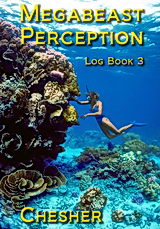Symbiosis, Symbiosis, Everywhere
The camp is almost invisible in the pouring rain. Everyone has gathered under the big tarp having breakfast. I anchor the dinghy and Freddy and I run up the beach, the cool rain running little rivers over our faces. A gust of wind blows the rain into the shelter with us.
"Lovely day," says Colin.
"By English standards," Freddy replies. The weather has been rotten for several days and everyone looks dismal.
"I guess we'll give it a miss today," I announce. Nods of misery and stringy hair.
"We could go diving anyway, what difference does it make if it's raining?" Chuck says.
"It's not so much the rain as it is the wind. It's too rough to go to the outer barrier today. We can do some snorkeling in the lagoon later, if you want."
"Count me out," Louise sniffs, I'm getting a cold.
"Me too," Anastasia gets up to pour herself another cup of coffee.
"We saw some sea turtle marks in the sand earlier, just before the rain hit," Mike tries a new subject.
"Oh really? We should go look tonight. Maybe they will come up and lay their eggs." Freddy says.
"Tell us some more about coral reefs and things," Patty says.
"OK, how about the story of the Megabeast called Nothing Atoll?" I ask.
"Sounds good to me," Colin says. I look at him. He's heard variations of it on the previous expeditions.
So, I tell them about how the atoll formed and the way all the parts of the reef - corals, fish, crabs, echinoderms, algae - all interact to form one living, integrated being. I wind up with my vision of the larvae drifting off like sparkling ideas of how to build new coral colonies on other undersea hills. It's a comfortable, rainy-morning story time under the tarp. The wood fire hisses and snaps and the rain drums down while I talk.
Later, Freddy builds a kite out of some cloth and beach sticks. She flies it with a fishing rod. It soars and dips in the strong winds and finally crashes into the trees. I assemble our data on invertebrate distribution and work on the report. The rain comes down and down and down.
At dinner time, the team assembles again under the tarp and I carry on with my talks about corals.
"Let's talk about Symbiosis. OK? Symbiosis is a technical term, meaning to live together. It originally referred to the association between single celled algae and a fungus that together make up what we call a lichen. Today it is used to describe intimate associations between organisms, specifically, a plant and an animal living together as a team.
It is a form of commensalism or mutualism where both partners benefit from the association. Reef building corals are a perfect example of this. They are an association of a single-celled creature, a dynoflagellate, called zooxanthellae, and the coral cells.
Zooxanthellae are independent little creatures, with their own genetic identity. At one stage of their life cycle each cell has a flagellum and it swims quite well as a member of Sea's zooplankton community.
When the dinoflagellates "infect" a coral, entering into the space between the coral cells, they lose their flagellae and take up permanent residency in the coral's tissues.
The zooxanthellae are small - some 7000 of them could fit on the period on the end of a sentence.
The chloroplasts inside the zooxanthellae take wastes from the coral cells - CO2, phosphates and nitrates - and produce oxygen, water, amino acids and sugars.
Zooxanthellae use the wastes from the coral and the coral uses the wastes from the plants."
"Not a bad deal," mutters Mike.
"Not bad at all. There are alot of zooxanthellae in corals. In fact, the colors of living corals come from the plant tissues within them. Plant cells outweigh the coral cells some 3 to 1. Under stressful conditions, a coral can eject the zooxanthellae. When they do, the animal tissue is completely transparent and the white skeleton gleams through.
"The zooxanthellae help the corals grow. The chemical interaction between the coral cells and the zooxanthellae facilitates crystalization of calcium carbonate so the symbiotic partnership grows much faster than coral could do it alone. Experimentally, the coral can survive for awhile without zooxanthellae. When conditions return to normal, zooxanthellae reinfect the corals.
"OK, now. Here's the tricky part. We can look at this association several ways. One way to see it is as an infection. The zooxanthellae - independent little creatures - have infested the corals and are using the corals as a supplier of food and shelter as well as a substrate for growth. The zooxanthellae are the master parasites.
"Or, we can see it another way. The corals have enslaved the zooxanthellae and use them as a waste disposal system, skeletal augmentation system, and source of foods. The coral is the master. This is easy to imagine as we now know that the ameoboid coral cells actually fetch the zooxanthellae spores from the coral gut and lug them into position between the other coral cells.
"Or, if you want, you can see the relationship as the corals and the zooxanthellae in a balanced, mutualistic association - called symbiosis - and both benefit and neither are harmed."
"The latter is the current biological viewpoint." Everyone looks interested and the rain hammers down on the tarpolin. So far, so good.
"There is still another way to look at it. In this view, the coral and zooxanthellae are not two different independant beings, they are one living system. The big coral colony, made up of coral cells and zooxanthellae, is a single being. It is one entity, and would not exist at all were it not for the intercommunication network of the whole system. It evolved the way it did, it has the form and behavior it does, because of the association between all of its sub-parts. "
"Modern reef building coral colonies would not exist at all without the eons-long association of zooxanthellae and coral cells."
"How is this different from symbiosis?" Mike asks.
"It's a difference in viewpoint, not a disagreement about what happens. From this view, the manifestation of the coral colony on the sea floor is the result of the evolutionary and present interaction between all the players that act out the form of the living coral; zooxanthellae as well as the thirty or forty different kinds of coral cells."
"But, as you said, the coral and the zooxanthellae can - experimentally or under stress - exist for a time as independent beings." Colin has evidently been giving this some thought since he heard it the last time. "Also, they have different sets of chromosomes and genes. This means they have a very different evolution."
"Yes, that's true, up to a point. The point when they became a united system - some 200 million years ago. Since then, their merger resulted in the common evolution of the existing species of corals. They retain their identity as individuals in the merger, but the whole being only exists as the culmination of their combined behavior integrated within their environmental domain." Several sets of eyes glaze over at this point.
"OK. Look, experimentally, a single coral cell can survive isolated from the system, but all by itself it is not a coral colony. And within each coral cell we find still smaller individuals that can be kept alive experimentally - sub-structures of the cell such as flagella, mitochondria, centrioles, and nuclei of the modern coral cells. Each of these also has its own DNA memory systems, separate from the others, and reacts as individual beings. But a single nucleus is not a coral cell.
"The chloroplasts in the zooxanthellae have a different DNA system from the flagellum, mitochondria, and nucleus in the dinoflagellate cell. We don't have any mental problem seeing a zooxanthellum cell or a coral cell as a little being even though each one is a community of separate, smaller creatures acting as one larger one. "
"In exactly the same way, the coral colony is a complex manifestation of the synergetic interaction of all of its components. It simply would not Be, it never would have become or evolved, if not for the whole assembly of smaller individuals - zooxanthellae and coral cells - all behaving as one larger being, the coral colony. And, to carry the thought one layer further, the huge tropical coral reefs would not exist if not for the whole assembly of different species of corals and algae and fish and other sub-parts of the behavioral system."
"But what's wrong with the concept of symbiosis?" Colin demands.
"Why, nothing. There's nothing wrong with the association being looked at as symbiosis, or as parasitism, or as the coral farming the zooxanthellae. They all have merits and each viewpoint also has limitations. Symbiosis ran into problems when it turned out virtually every modern cell in every living multicellular organism is a symbiotic relationship of proto-bacteria. It's usefulness as a descriptive term becomes limited because the association applies everywhere. Symbiosis, parasitism, or coral farming the zooxanthellae all focus on the relationship between separate entities.
"In the new view, the focus is on the manifestation of entities by relationships. It is a recognition of the universallity of the relationship, and the existence of the so-called separate entities as relationships themselves. A focus on the communications between chloroplasts, mitochondria, nucloli, cilia organizing their behavior - and their evolution - to create a new level of communications as modern cells. A focus on the communications between coral cells and zooxanthellae to become a still larger association. And it carries our thinking further, linking together associations we ordinarily would not be able to integrate into one logic system. We have always been philosophically confused over the one and the many, the individual and the collective, particles and waves and especially between mind and matter. Our science grew up on duality and can't connect the two.
"From this new viewpoint, the entire coral complex, is seen as a network of communicating behavior patterns, nested one within the other. It extends seemlessly from the interactions of organic molecules creating the cellular organelles, the communications of cellular organelles to create the cell. The communications between cells to create the polyps, the communications of the polyps all working together to create the coral colonies, the coral colonies and all the associated reef fauna and flora interacting to form the coral reef ecosystem. The focus is on the intercommunications. The intercommunications manifest the so-called individual beings."
"From this viewpoint, the whole atoll here can be viewed as a single network of communications, a megabeast, thousands of years old, manifested by the communications of all of its sub-component behavior systems. The behavior of the individual fish and turtles and crabs and clams and corals and sponges result in the megabeast atoll and, at the same time, the megabeast atoll creature dictates where each of the individuals will grow and what they will do - just as the behavior of the whole assemblege of cells manifests the coral colony, and the form of the whole coral colony dictates where each cell will grow and what they will do.
"The beauty of this viewpoint is the way it integrates the entire living system, from the nested behavior of sub-atomic particles into atoms to the nested behavior of all living parts of an ecosystem into a living sea. As a network of communications, the system becomes more and more complex, it learns, it evolves."
The rain has stopped. Everyone is looking blank. Damn. "Let's go see if there are any turtles," I suggest. The team works its way through the island path to the eastern side and we sit on the top of the beach and watch for sea turtles to come up the beach to lay their eggs. Although we see some turtle-like shadows in the water, none venture up onto the sand.
"Do you believe in God?" asks Mike as we walk along the beach. Mother Sea, give me strength.



